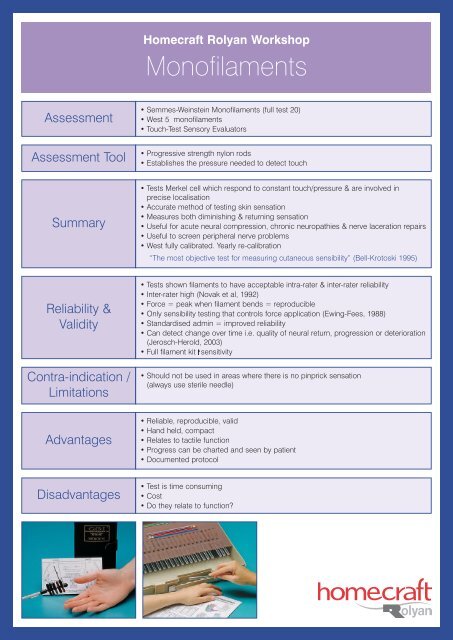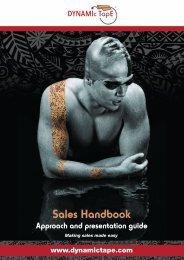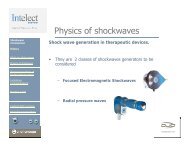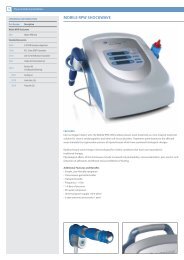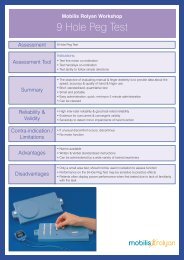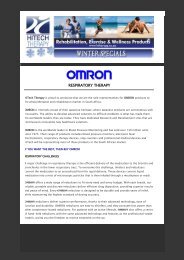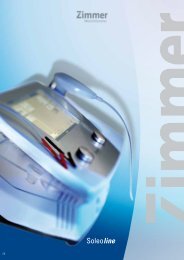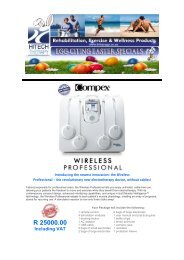Monofilaments
Monofilaments
Monofilaments
You also want an ePaper? Increase the reach of your titles
YUMPU automatically turns print PDFs into web optimized ePapers that Google loves.
Homecraft Rolyan Workshop<strong>Monofilaments</strong>AssessmentAssessment ToolSummaryReliability &ValidityContra-indication /LimitationsAdvantagesDisadvantages• Semmes-Weinstein <strong>Monofilaments</strong> (full test 20)• West 5 monofilaments• Touch-Test Sensory Evaluators• Progressive strength nylon rods• Establishes the pressure needed to detect touch• Tests Merkel cell which respond to constant touch/pressure & are involved inprecise localisation• Accurate method of testing skin sensation• Measures both diminishing & returning sensation• Useful for acute neural compression, chronic neuropathies & nerve laceration repairs• Useful to screen peripheral nerve problems• West fully calibrated. Yearly re-calibration“The most objective test for measuring cutaneous sensibility” (Bell-Krotoski 1995)• Tests shown filaments to have acceptable intra-rater & inter-rater reliability• Inter-rater high (Novak et al, 1992)• Force = peak when filament bends = reproducible• Only sensibility testing that controls force application (Ewing-Fees, 1988)• Standardised admin = improved reliability• Can detect change over time i.e. quality of neural return, progression or deterioration(Jerosch-Herold, 2003)• Full filament kit sensitivity• Should not be used in areas where there is no pinprick sensation(always use sterile needle)• Reliable, reproducible, valid• Hand held, compact• Relates to tactile function• Progress can be charted and seen by patient• Documented protocol• Test is time consuming• Cost• Do they relate to function?
Administration• Distraction free, quiet environment, vision occluded• Seat patient at table with hand supported on towel, therapeutic putty (supportessential as any movement may be felt). Fix part to be tested• Demonstrate testing method to patient• Draw attention to the site to be tested with supra threshold stimulus (work to lightest)• Start on volar surface• Apply monofilament perpendicular to skin until filament bends for 1.5 seconds.Force of application = when filament bends• 5 applications should be made - 1 or more correct responses indicate that thresholdis perceived• Include 2 sham tests• Filament should be applied in 1.5 sec, on site & lifted in 1.5 sec• Mark zone & number of lowest filament or colour perceived in each area & date• Delayed response greater than 3 seconds = abnormalMonofilament ClassificationMonofilament Size Force in Grams (g) Cutaneous Sensory PerceptionGreen 2.83 0.07 NormalBlue 3.61 0.2 Diminished light touchPurple / Pink 4.31 2.0 Diminished protective sensationRed 4.56 4.0 Loss of protective sensationOrange 6.65 200 UntestableReferences:Bell-Krotoski J. Weinstein S. Weinstein C. (1993) Testing sensibility; including touch pressure, two point discrimination, point localisation & vibration. Journal ofHand Therapy. 6:2: 114-123.Fees E. (1995) Guidelines for evaluating assessment instruments. Journal of Hand Therapy. 8: 144-58Jerosch-Herold C. (2005) An evidence based approach to choosing outcome measures; a checklist for the critical appraisal of validity, reliability &responsiveness studies. British Journal of Occupational Therapy. August 68(8); 347-353Novak C. (2001) Evaluation of hand sensibility a review. Journal of Hand Therapy. 14:4: Oct-Dec. 266-278.Simpson C. (2005) 2nd Ed. Hand Assessment: A clinical guide for therapists. Cromwell Press Ltd.AW00212 Is2


